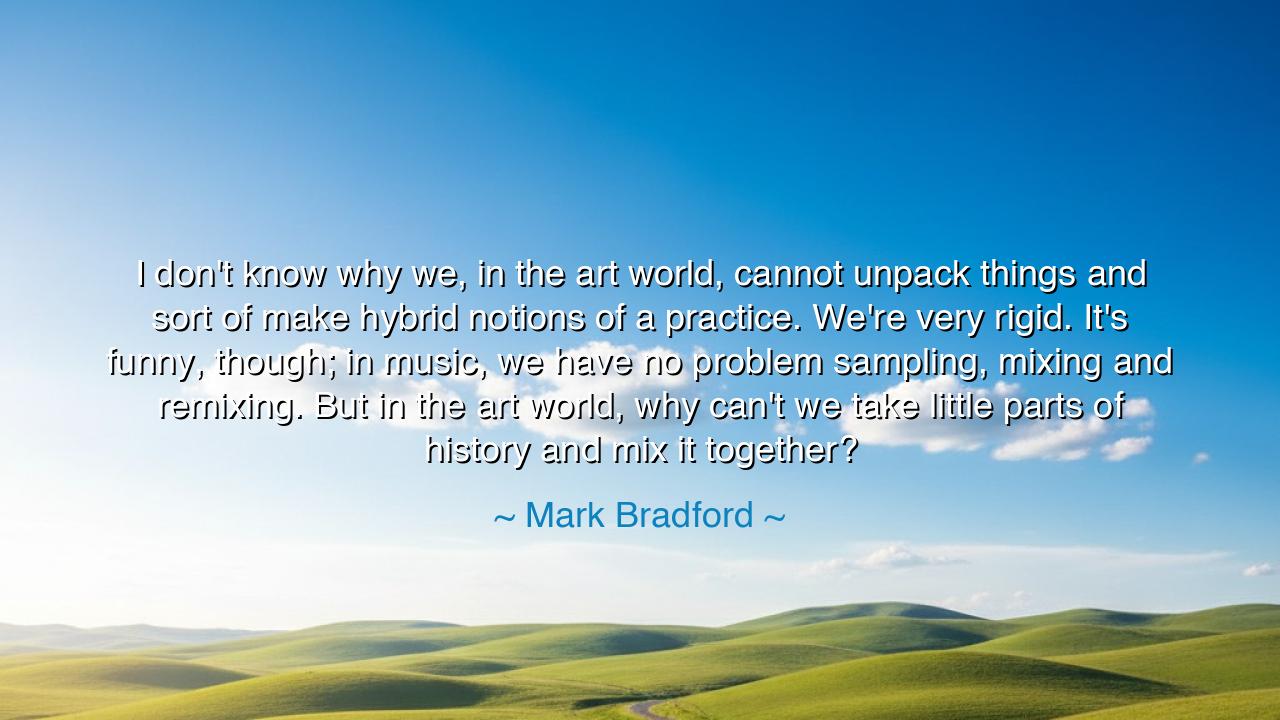
I don't know why we, in the art world, cannot unpack things and
I don't know why we, in the art world, cannot unpack things and sort of make hybrid notions of a practice. We're very rigid. It's funny, though; in music, we have no problem sampling, mixing and remixing. But in the art world, why can't we take little parts of history and mix it together?






The words, “I don’t know why we, in the art world, cannot unpack things and sort of make hybrid notions of a practice. We’re very rigid. It’s funny, though; in music, we have no problem sampling, mixing and remixing. But in the art world, why can’t we take little parts of history and mix it together?” come from Mark Bradford, the celebrated American artist whose work weaves together fragments of history, culture, and identity into something profoundly new. In this reflection, Bradford speaks not only of art, but of the fear of fluidity, the tendency of society to separate, label, and fix meaning where it should flow. His words challenge us to think like creators—to see life as a canvas open to hybridization, transformation, and remixing, where the old and the new dance together to form the future.
In the style of the ancients, we might say that Bradford speaks as a philosopher of creation, calling us back to the primal truth of invention: that nothing born in this world is wholly original, yet everything that exists can become new again through the touch of imagination. The ancients themselves knew this well. The sculptors of Greece borrowed from Egypt; the poets of Rome reimagined the myths of Greece; even the sacred texts of nations grew from the voices of those who came before. To remix history is not to steal—it is to honor, to recognize that wisdom is cumulative, that art is a lineage. Bradford laments that the art world, in its obsession with boundaries and definitions, forgets that creation is not about ownership, but connection.
When he compares art to music, Bradford reveals something profound about freedom. In music, the act of sampling—lifting a rhythm, a melody, a voice from the past—is celebrated as innovation. Hip-hop, jazz, and blues all live by this principle: they take fragments of history, reshape them, and give them new rhythm. The ancient bards did the same when they sang the same legends with new verses for each generation. Bradford asks why visual art cannot embrace this same liberty. Why must it cling to purity and originality when all of human culture is a mosaic of influences? His question is not merely about galleries and paintings—it is about how humanity resists mixing, resists hybridity, resists the beautiful complexity that defines life itself.
Consider the Renaissance, that great awakening of art and thought. It was not born from isolation, but from synthesis—the revival of Greek philosophy, Roman architecture, Christian mysticism, and Arab mathematics. Leonardo da Vinci did not fear to combine science and painting, geometry and imagination; his mind was a workshop of hybrid creation. What Bradford observes is that our modern world, for all its progress, has grown more rigid in its categories. We seek to define and divide—high art from low art, tradition from modernity, artist from craftsman—forgetting that genius thrives in the crossroads. He reminds us that the true artist must be like the alchemist: blending, fusing, transmuting until something entirely new is born.
In his own work, Mark Bradford embodies this philosophy. He builds his massive, textured paintings from fragments of street posters, billboards, maps, and advertisements—discarded remnants of urban life. From these scraps, he creates something luminous and profound, showing that even the forgotten and the broken can form beauty when reassembled. This is the art of hybridity, the art of seeing value in what others deem chaos. Bradford’s process is the very act he describes: taking “little parts of history and mixing them together.” In doing so, he turns collage into metaphor—a vision of a world where diversity itself is art.
There is also a moral truth in his words: rigidity is the death of imagination. The artist who refuses to mix ideas, who clings to purity of form, becomes sterile; and the society that fears hybridity loses its vitality. Bradford’s question is thus a challenge not only to artists but to all who live within systems that define and divide. He invites us to break the walls that separate disciplines, cultures, and generations, and to build bridges of shared expression. Just as music reminds us that the past can pulse through the present, he urges us to see that our lives themselves are remixes of those who came before—our thoughts, our languages, our very identities are the artful blendings of countless histories.
So, my child, take this wisdom into your heart: do not fear to mix, to blend, to borrow, to evolve. Everything that lives grows by change. The river does not apologize for taking the colors of the earth it flows through, nor does the flame apologize for consuming wood and giving light. In the same way, let your work—your life—be a collage of all you have touched and loved. Honor your influences, but do not be bound by them. Create something that speaks with many voices and yet sings in your own.
For in the end, Mark Bradford’s words are not only about art but about the spirit of creation itself. To remix history is to keep it alive. To weave the past into the present is to honor it more deeply than preservation ever could. Let your practice—whatever it may be—become a symphony of blended truths, a testament that beauty grows richer when boundaries dissolve. And remember: just as music finds freedom in rhythm, so too does the soul find freedom in the act of becoming something new.






AAdministratorAdministrator
Welcome, honored guests. Please leave a comment, we will respond soon